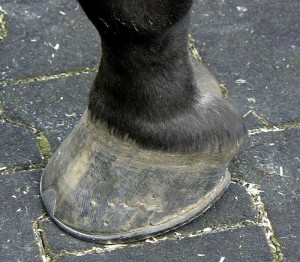Racing pushes horses to their ultimate extremes. During a race a horse will reach speeds of 45 mph with a heart rate of 240 beats/min and a respiration rate of 140 breaths/min. There are many factors that contribute to a horse’s ability to compete at such high speeds, but in this section we will only discuss the factors that are influenced by humans.
The majority of thoroughbreds begin racing as two-year olds and reach the peak of their careers by the age of four. In Canada, disciplines such as Eventing and Dressage require horses to be a minimum of four years old when they enter their first competition. All thoroughbred race horses, no matter when they are born, are said to have been born on the 1st of January in their year of birth. For example a foal born May 1st, 2008 would have January 1st 2008 written on their registration papers. A foal born as late as May will be five months less developed then its racing partners who were actually born in January and will therefore not be as strong of a racer. This encourages breeders to tamper with natural estrous cycles in order to have foals born in January and February.
A very important factor in the success of a racehorse is their size and their strength. Young horses grow height wise very quickly, but do not reach mature weight (bone, muscle and fat mass) until they are three to five years of age.
There following are three growth factors that racehorse trainers and breeders can control.
1. Genetics:
Breeders are now selecting for larger horses, in order to get horses with longer strides who ultimately run faster. Muscoskeletal injuries are extremely common in horse racing: 83% of racing and training deaths are associated with muscoskeletal injuries. Breeders should therefore focus on breeding sound animals, not just large ones. For example, Stover suggests that hoof conformation plays a role in determining the risk of injury in race horses. Breeders should therefore choose to breed for better hoof conformation over horse size.

2. Nutrition:
Nutrition cannot overcome genetics but feeding the right diet can help increase the development of muscle mass.
Because horses vary by the individual specific dietary requirements cannot be made. Generally a horse’s diet is determined by their size, age, temperament, condition and exercise regime. Unfortunately horses, especially racehorses, tend to be very susceptible to stressors such as changes in the environment, their schedules and their feed. These stressors contribute to gastric ulcers. To reduce the acidity in the horse’s stomach trainers and horse owners should reduce the amount of concentrated feed (not hay) that the horses consume. This is difficult with racehorses because they get most of their energy from concentrates.
3. Exercise:
Regular exercise is good for growing horses, however it has been shown that both length and intensity of exercise must be strictly controlled to avoid injury.
Stover suggests that exercise is a probable cause for the development of injury due to the loading on bones and tissues. The development of injuries through exercise vary by horses age and condition, but are most prevalent in horses exercising at higher speeds and longer distances.
Trainers should focus on shorter bouts of high intensity workouts, and completely avoid running the horses at high speeds for long distances. Trainers, owners and jockeys should also take the time to assess the horses before and after each ride and take preventative measures before minor injuries become catastrophic.

This is an example of a horse falling on the track. Although the cause of this specific fall is not given, this horse may have been suffering from a previous minor injury that turned catastrophic during the race. This situation puts the horse, their jockey and others in danger.
